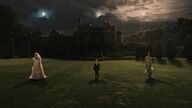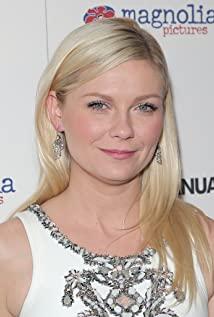In theaters, the bar for mental health manifestations has always been low. Whether it's depression or more serious mental illness, they're typically represented in films either as cannibalism, stigmatization, or both. Perhaps most reproachful is that it is often used as a catalyst for violence, as in 2019's Todd Phillips' Joker.
But, of all those problematic descriptions, probably no film has portrayed a psychological crisis more deeply and compassionately than Lars von Trier's 2011 "Melancholia."
Ten years ago in May, the film premiered at the Ghana Film Festival. At a subsequent press conference, von Trier said he was a Nazi, which immediately led to the film's controversy. He himself was banned from the festival for seven years. But, as the dust settles, the film deserves to be recognized as a monumental masterpiece. It goes beyond the cultural context in which we currently think about mental health crises and unleashes the power of cinema to depict how mental illness can transform the human soul.
In fact, Melancholia is the second in von Trier's trilogy of depression. The other two are Antichrist and Nymphomaniac. Through this trilogy, he explores different ways of presenting his experiences of depression using another facet of the female personality. Von Trier described Melancholy when it was released as "a psychological disaster film" and "a beautiful film about the end of the world". It revolves around a young woman (Kirsten Dunst) named Justine (Von Trier's stand-in), and describes the exhausting depression she experiences when the world does come to an end. At that time, a blue planet named Melancholia loomed in the sky and was about to hit Earth.
The film is divided into two parts. "Part One: Justine" focuses on Justine's wedding day. The film begins with Justine and her new husband Michael (Alexander Skarsgard) in a stretch limousine. Both giggled when the driver was unable to make a turn on the narrow country road. Justine and Michael eventually arrived at their reception two hours late. Since then, everything has been screwed up: Justine has a depression, Michael is heartbroken, her sister Claire (Charlotte Gainsbourg) is jittery, her copper-clad brother-in-law John (Keefe Souther) Ran) is indifferent and does not understand. However, the film's "Part II: Claire" is on the cards. As the melancholic planet draws closer to Earth and the end of the world is imminent, Claire's anxiety intensifies, while the deeply depressed Justine, on the contrary, calmly accepts their fate. "The earth is evil, and we don't have to be sad about it," she said. Her sobriety came from her own despair. In the face of impending destruction, her despair is like an existential courage and the ability to face the truth. Meanwhile, John shows that he is a coward. The situation at that time has exposed everyone's true side.
What makes this film especially unusual is that its central idea of despair is a visual feast. As explained by the film's cinematographer, Manuel Alberto Claro, some of the images in the film's storyboard were carefully drawn by von Trier. That's a tribute to other works of art. For example, imagine Justine in her wedding dress floating in a stream like Millay's Ophelia. There are also images derived from von Trier's dreams. They were dubbed "Wagnerian moments" by von Trier - a reference to the moving effect of Richard Wagner's opera Tristan und Isolde throughout the film. Most striking is its overture, which consists of a series of thrilling micro-scenarios, all in super slow motion at about 1,000 frames per second: the heroine as Ophelia; a close-up of the heroine as the birds fall from the sky. Shot; Claire runs across the golf course with her baby in her arms; the horse falls to the ground; the heroine in her wedding dress is tied tightly by grey wool from a tree. From von Trier’s perspective, these visual feasts give the depressive state a perverse richness—people sinking into the quicksand of their minds and bodies feeling things with extravagant depth. Often they just can't express it.
Claro told BBC Culture that he was initially worried that the film would be "too beautiful" because it was filmed in Sholholm Castle in Sweden. "Sometimes you read a script and it feels like it's going to be what I call photographic candy. You have a big wedding in a castle and your world falls apart, instead of falling in love with the characters in it." But, Claro is overwhelming The camera stays on Justine and Claire most of the time, following their heels like loyal hounds, capturing every expression on their faces. By doing so, he counteracts the beauty he said in the first place. Then, when the wide-angle lens captures the surrounding environment, or the scenery like a painting, beauty emerges again like sudden music.
why movies are so powerful
Melancholia is a sort of talisman for fans who have experienced depression a decade after its release, and that's the film's inherent strength in portrayal. It's so powerful because it refuses to do what people with mental illness usually do when they're under stress: reduce suffering. It's the kind of challenge that makes the pain so great that it's truly a doomsday prologue. High-tech sci-fi and actually nuanced characters and relationships blend seamlessly.
There's no question that Kirsten Dunst's performance as Justine transcends Von Trier's filmmaking art. It was a masterful achievement, raw, physical, emotional and complex, and earned her the Best Actress award at the 2011 Ghana Film Festival. Kirsten Dunst mentioned her experience with depression in press coverage of the film, and she sought help in 2008. The experience still seemed alive in her body's muscle memory.
Part of what makes The Melancholia so special is that when it portrays mental health issues, it acts as an antidote to the bad records of film and television. The USC Annenberg Inclusion Initiative, in its May 2019 Report on Depicting Mental Health in Film and Television, found that the 100 best films of 2016 were filled with mental illness, which is in line with The real world doesn't fit in. Of the 4,598 spoken characters, only 0.4 percent of 18 were portrayed as suffering from depression, when in fact 21.4 percent of Americans will experience an affective disorder once in their lifetime. Also, in films depicting depression, depression is often caused by an identifiable cause, such as the death of a loved one or physical disability. In fact, depression isn't always triggered by dramatic events. Research also shows how depression is often used to express exclusive story themes involving discrimination and suicide. In other words, it is still instrumentalization to enhance narrative rhythm or scan social perspectives. By contrast, Melancholia does not use depression as a tool, but as part of its own texture.
The person whose exploration of depression resonates is journalist and project manager Julie. She is about 25 years old. She stumbled across the film when she was a teenager. But when she watched it again in 2019, the similarities left her in awe as she looked back. She is married in a castle like Justine, and like Justine in one particular shot, in the shower at the wedding, motionless because of the pain. When the second part of the film begins, Justine is like a walking dead. Julie remembers that she went through the same state due to depression. "I was autistic and felt like everything I was doing was completely out of touch with reality. It was a dream state. I went to sleep or went into autism whenever I could." Julie also highlighted the experience of Jia Jia. Si Ting's impulsive moment. Most notably, after being unable to confront and sleep with her husband, Justine ran out on the golf course to have sex with a guest she just met at the wedding. Julie understands the logic. "You're giving up all sense of control and letting yourself fall into a state where you don't know or understand what you're doing. You just want to feel something. You want to feel like you're part of this moment in time and place."
Screenwriter Jamie Graham also felt that Melancholia was an extremely raw film. He is now the editor of Large of Total Film magazine. He recalls watching the film for the first time at its Ghana premiere in May 2011, when he himself had been suffering from depression for three or four years. He told BBC Culture: "I remember it very well: I felt like the person who wrote the script and directed it must have had personal experience. I've never seen depression expressed in such a way in any other film. So it's a very personal thing for me. Then, when I found out that Kirsten Dunst also suffered from depression, it all came to light because her performance felt so alive and truth."
For Graham, Von Trier is the most realistic portrayal, in part because he doesn't have any exposition, or backstory, or attempt to understand the way Justine's state of mind sends us into her depression. "People always say to you: Why do you feel this way? I can't tell. You know, nothing is like the death of my parents. It's like clouds from the sky falling on me. Understand that. Justine looks like a lucky one. She had an incredible wedding, married to this wonderful person who understood her most of the time and knew she loved her. She had a good job, she was like Everything goes well. But none of that matters at all. When you've got depression, nothing matters, nothing shakes it. You just can't do anything about it."
He was struck by the way von Trier showed the physical side of depression: how depression can produce a deep-seated heaviness that makes no matter what you do feel laborious. In the second part of the film, in another shower scene, Claire tries to get Justine to dip over the edge of the bathtub. But Justine couldn't do it, she just slumped in Claire's arms. Graham said: "That really struck me, because when depression is particularly severe, that's how people feel. I've never seen that in any other film. Depression eats the soul, Overpowering and consuming everything. It's not just that you're down or gloomy, it affects your whole body so much that you can't even move. Justine had a line: she felt like she was dragging grey wool Was walking, being dragged backwards. In the past, when I went to work to answer six emails, it seemed like a mountain to climb. When you feel good, answering emails is a very basic thing, You can get rid of one in a minute. But I was like: Six emails, I can't handle it, I just want to go home."
lack of understanding
If the film is remarkable in its portrayal of Justine's mental confusion, it is equally powerful in its portrayal of a lack of understanding of what people with depression often have to contend with. This attitude is expressed through the mouth of Justine's brother-in-law, John. When he tried to stress to her how much the wedding cost, his crude logic was like psychological violence in the face of her helpless vulnerability. For Graham, this indifference was reflected in real life through some of the reactions he encountered when the film was screened at the Ghana Film Festival. "I remember hearing other reporters talk about the film and they didn't understand it at all. Their attitude was: Hey, don't be smug, cheer up. You had such a good wedding, you looked like you were born into a wealthy family, what do you have? So sad?"
Melancholia's remarkable portrayal of depression is not just in the details, but in its entire worldview. It dares to say: The worldview of depression is correct. The end of the world is coming, and resistance is futile. All you can do is accept this disaster, relax, and enjoy this last beauty.
Both Jolie and Graham are feeling mentally healthier now, so what's it like going back to the cinema to see this film? For Jolie, the film remains an unusual comfort. "'Melancholia' has helped me unravel what seemed to be unsolvable mysteries. I rewatched the film often, immersed in the knowledge that I was not a weirdo." She admits: The logic of the film can be devastatingly tempting force. She said: "It's like a hand pulling you back to where you were trying to escape. But for me, the film is comforting, even reassuring. And, I'm sure I'll keep revisiting it It." But for Graham, revisiting the film was more disturbing: "I think it's a sad film that upsets me, maybe because it's so close to what I've felt. Von Titty The way you paint the end of the world is that they sit and the planet gets closer and closer to Earth, and you can really feel the horror."
In the 10 years since The Melancholia was released, the mental health discussion seems to be continuing. More and more individuals are using their platforms to confess their experiences of mental illness, hoping to contribute a little of their own to de-stigmatize mental illness and educate people. But Melancholia is more powerful than ever, for it brings us to a primal connection to the subject of the hallmarks of great art.
Julie is a pseudonym because she wishes to remain anonymous.
(Note: The compiled article comes from the BBC)
View more about Melancholia reviews











